The Metropolitano de Lisboa,
The Metro do Sul do Tejo and
The Metro Ligeiro de Superfície
The following text describes, firstly, the Lisbon underground city metro system, then the metro system opposite Lisbon on the south bank of the Tagus (to which a separate page is dedicated here) and, finally, a proposed light Metro system which will encircle Lisbon.
Guide
A superb all-colour guide to the Lisbon metro is the publication Metros in Portugal, written by Christoph Groneck and translated by Robert Schwandl & Mark Davies. It was published in 2008, in Berlin, by Robert Schwandl Verlag and is liberally illustrated through its 144 pages (ISBN 978-3-936573-20-6). The text is in parallel columns of German and English. Despite its title it also has summary coverage of Portugal's tramways and suburban railways. It is thoroughly recommende and can be acquired in the UK from the excellent MDS Books.
Metropolitano de Lisboa
The Metropolitano de Lisboa, or 'Metro', is the underground railway system which serves the Portuguese capital. It is a 750 volt third-rail system built to the European standard 1.435m gauge. Construction commenced on 7 August, 1955, six years after approval was granted, and the system opened on 29 December, 1959. At the time it was Europe's 14th underground system and the 25th to be built in the world. Built largely by the "cut and cover" method, it ran from Restauradores to Rotunda (now M. do Pombal), where it split into two, one line going to Entre Campos and the other to Sete Rios (now Jardim Zoológico). It carried 15.8 million passengers in its inaugural year of operation, by 1967 ridership topped 30 million and more than doubled to 70 million in 1972. By 2006, 184 million passengers were being carried.
The Metro system runs (2012) on a network comprising four lines. These have a confusing array of names being described on Metro signage as Blue, Yellow, Green and Red, or Gaivota (Seagull line), Caravela (Caravel line), Girassol (Sunflower line), and Oriente (East line) respectively, whilst the operating company's literature and web-site also refers to them sometimes as lines A (blue), B (yellow), C (green) and D (red). The Metropolitano de Lisboa's own Web Page provides an updated map of the system.
History of the Network's Expansion
In 1963 the original network was expanded southward one stop to Rossio; it was then extended northwards, reaching Anjos (1966) and Alvalade (1972). Subsequent plans to extend eastwards along the north bank of the Tagus river were, however, abandoned at this stage.
Indeed, rather than extend the network further, it was decided to address the problem that all of the stations, except for those built for the 1972 extension project and those at Rossio, Rotunda, Entre Campos and Sete Rios, were only 40 metres long so could only accommodate two-car train sets. When four-car units were introduced, trains either stopped with two carriages still in the tunnel or ran as expresses and made stops only at the four-car-length stations. It took until 1982 to extend all of the 40 metre stations to 105 metres, which allowed for six car-sets to serve them but the stations with 70-metre platforms were left unextended at this stage.
Following this work, the emphasis returned to expanding the network. The western branch was extended from Sete Rios to Colégio Militar/Luz and the eastern line to Cidade Universitária from Entercampos, all of the new stations having 105 metre platforms, which opened in 1988. Next, the two arms of the system were joined by each being extended to Campo Grande (1993) which is an above-ground station with four lines. At this stage each line terminated there, without any through running. A new Metro depot was also provided, nearby, at Calvanas.
What was, crudely, a figure-six shape was then split into a U-shape by the line between Rotunda and Campo Grande being separated and becoming the Yellow Line; the rest of the network thus became a U-shape Blue Line, running south from Campo Grande via the city centre and back up north to Colégio Militar/Luz. This separation took place in 1995 and that year the Rotunda platforms were extended to 105m length as were those at Sete Rios.
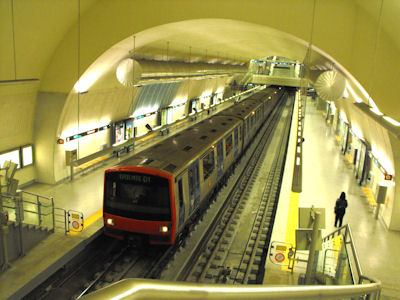
Left: The Red Line at São Sebastião, opened in 2009.
In 1997 both the Blue and Yellow lines were extended; the latter by one stop from Rotunda to Rato; the former from Colégio Militar/Luz northwards to Pontinha, where a new depot opened to replace the original one at sete Rios, which is now the site of Lisbon's main coach station. Sadly, that year, on 19 October 1997, a fire at Alameda station killed two people at a time when it was closed to the public for works associated with Red Line development. One of the fatalities was of a Metro worker at Areeiro who was overcome by fumes which came up the tunnel.
Major changes occurred in 1998 when the impressive Baixa-Chiado station was opened. This has an entrance in the city centre (Baixa) as well as one at a much higher level in the Chiado district, linked by a series of escalators. As a consequence of this, a Green Line was created, being the former section of the Blue Line running from Campo Grande via Alvalde, Rossio and Baixa-Chiado to its new terminus at Cais do Sodré, adjacent to the Cascais Line railway of CP, the tram route (15) and the ferry terminal.
Meanwhile, Lisbon was preparing to be the location of Expo 98 so a new Red Line was constructed to the Expo site at Oriente in the north east of the city. This started from the Green Line at Alameda. Oriente was also provided with a magnificent new CP main line station linked to the Metro by escalators, lifts and stairs. It was in May, 1998 that the Oriente line was inaugurated, though some of the intermediate stations opened later than the terminal station, e.g. Cabo Ruivo (opened July 1998), Olivais (November 1998).
Since then, further extensions have been opened, with the Telheiras extension from Campo Grande on 1 November 2002 followed in March 2004 by the Yellow line, which was doubled in length to Odivelas from Campo Grande. Next, in May 2004, Amadora Este became the terminus of the Blue Line, beyond Pontinha. An extension to the airport opened in 2012.
The remaining Green Line stations (except Areeiro and Arroios) have been extended from 70m to 105m to allow six-car operation. Finally in December 2007 the long delayed extension of the Blue Line via Terreiro do Paço to Santa Apolónia main-line station was inaugurated. Plans exist to extend the Red Line further west to Campolide. An extension from Amadora Este on the Blue Line to link with the CP Sintra Line at Reboleira was envisaged with 2011 as a target date for completion, a goal only met several years later. Three new stations were also projected at Atalaia, Amadora-Centro e Hospital Amadora-Sintra, an extension of 2,5 km, costing some €240 millions but this has not materialised. Other major extensions are planned, not least an extension of the Yellow Line to link with the Cascais railway line at Alcântara.
Nevertheless, a significant number of new stations have been created in recent years, with the river-front link from Baixa Chiado via Terreiro do Paço to the mainline Santa Apolónia station opening on 19 December 2007, more than five years late due to tunnelling problems at the waterfront caused by water ingress. This extension provides a rapid connection, via a change at Baixa-Chiado, between the Cascais railway line and the bustling Praça do Comércio.
After years of the waterfront being scarred by the protracted works on the Terreiro do Paço underground station, the area was further blighted (c2009) as the Pç. Comércio was dug up for works on an old sewer and to underpin the eastern tower by the waterfront, which had settled over the years. Although Pç. Comércio itself has now been largely (but not completely - 2016) tidied up, the route between there and Cais do Sodré, to the west, was also affected by major work to upgrade the waterfront at Ribeira das Naus (2012). And to the east, the closure of the iconic Sul e Sueste ferry terminal has left something of an eyesore in the form of the redundant building.
Further extensions have seen the lengthening, to the west, of the Red Line from Alameda via Saldanha to São Sebastião, which opened on 29 August 2009 and this provides interchanges with the Yellow and Blue Lines respectively. It is therefore now possible to travel to Oriente from north-west Lisbon without having to journey via the city centre. An extension at the other end of the Red Line via Moscavide reached Lisbon airport in July 2012.
Plans and Developments
As of 2013 the Metro website listed the following planned developments:
Extension of Blue Line from Amadora Este to Reboleira, which lies on the CP railway line to Benfica. This has now been accomplished. The work included the estension of Areeiro and Arroios metro stations to platforms of 105 metres' length, allowing the use of six-car trains. It was also planned to refurbish the stations at Anjos e Intendente. On completion the network will comprise about 44.2km in lengthwith 56 stations.
So the network in 2016 comprised...
- Linha Azul/ Blue Line, Reboleira to Santa Apolónia, 13.7km and 18 stations
- Linha Amarela/ Yellow Line, Odivelas to Rato , 11.1 km and 13 atations
- Linha Verde/ Green Line, Telheiras to Cais do Sodré, 8.9km and 13 stations
- Linha Vermelha/ Red Line, S. Sebastião – Aeroporto, 10.5km and 12 stations
In 2017 it was announced that the Yellow Line would be extended to Cais do Sodre from Rato via new stops at Estrela and Santos. For some two years during construction, the tram routes 15 and 18 would be moved from the coastal alignment from Cais do Sodre towards Belem and would operate, instead, more inland on the current route 25 alignment from Corpo Santo to Santos.
Longer term, the plan is to make the Green Line a circular route which would encompass the current Yellow section from Campo Grande to Rato, whilst the current Green link to Telheiras from Campo Grande would be incorporated in the Yellow Line.
Today's Metro Lines
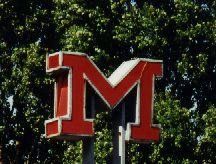
Right: An old style Metro sign at the entrance to Praça de Espanha station.
Blue Line, or Gaivota (Seagull) Line, or Linha A. This line runs from Amadora Este (a new terminus opened on 15 May 2004) via Alfornelos and Pontinha, south to Baixa-Chiado. This line was finally extended via Terreiro do Paço to Santa Apolónia, the international railway station, to the east of the city centre on 19 December 2008. At Marquês de Pombal there is an interchange with the Yellow Line.
Yellow Line, or Girassol (Sunflower) Line, or Linha B. From 27 March 2004 this line was extended out to Odivelas from where it runs via Campo Grande, the only surface station on the system, south via Cidade Universitária, Entre-Campos, Campo Pequeno, Saldanha, Picoas, Marquês de Pombal and terminates at Rato, near the end of the Lisbon acqueduct and not far from the back of the Estrela gardens. The 2004 extension north of Campo Grande brought new stations into operation at Quinta das Conchas, Lumiar, Ameixoeira, Senhor Roubado and Odivelas. A southern extension is also planned from Rato via a new station at Infante Santo to Alcântara Mar on the Cascais railway line.
Green Line, or Caravela (Caravel) Line, or Linha C. Until 2 November 2002, when the Telheiras extension opened, this line was 9km long and had twelve stations emanating from Cais do Sodré in the south, where there is an interchange with the Estoril rail line, the Metro and the new ferry terminal, as well as with Carris trams and buses. The line passes through the central stations of Baixa-Chiado, Rossio and Martim Moniz to the interchange with the Yellow line. at Campo Grande. Intermediate stations are at Intendente, Anjos, Arroios, Alameda (interchange with Red line) Areeiro, Roma, and Alvalade.
Red Line, or Oriente Line, or Linha C. This line initially ran for 6km from the Green Line at Alameda north east to Oriente, the location of the Expo 98 site - now the location of the Feira Internacional de Lisboa (since March 1999) where trade fairs and similar events are held.
A new shopping centre, called Vasco da Gama, opened at Oriente too, whilst four of the Expo pavilions, including the oceanarium remain. Intermediate stations are at Olaias, Bela Vista, Chelas, Olivais, and Cabo Ruivo, the last-named of which opened in summer 1998. Cabo Ruivo is the only unadorned station on the line; the other stations having striking artistic finishes and being built on a larger scale than earlier metro stations, more as a statement to the world then because they are heavily used.
For a map of the proposed extensions visit UrbanRail.net.
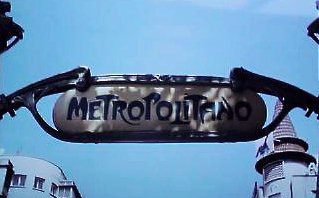
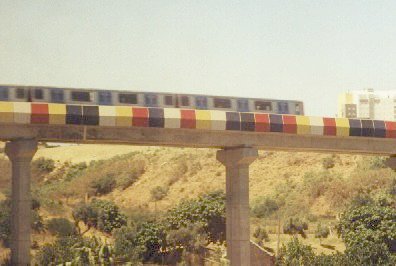
L to R: The unique French Métro art nouveau sign outside Picoas Metro station; a Metro train crosses the short stretch of open-air viaduct over the CP Oriente to Queluz line between Olaias and Bela Vista on the Red Line.
Station Names
From 1 March 1998 several stations were re-named:
Martim Moniz (formerly Socorro), now named after a twelfth-century knight who played an important role in the recapture of Lisbon from the Moors in 1147.
Jardim Zoológico (formerly Sete Rios). Sete Rios is still the name of a CP Portuguese Railways station adjacent to the Metro station. Also now sited here is the new Lisbon coach station, sited next on the former Metro sidings and works.
Marquês de Pombal (formerly Rotunda). The Rotunda is a large roundabout at the top of the Avenida da Liberdade. In its centre stands a striking monument to the Marquis of Pombal, the eighteenth-century autocrat who is credited with the rebuilding of Lisbon after the disastrous earthquake of 1755. The imposing buildings on grid-like streets in the Baixa area in central Lisbon are his most visible legacy to the city.
Praça de Espanha (formerly Palhavã).
Visitors should also note that the nearest station to Rossio CP railway station is Restauradores which has a subway link to the CP station. The Rossio Metro station is further away, albeit only five minutes' walk, above ground.
Stations and the Places They Serve
Below is a selection of the more common stations to be used by visitors to Lisbon.
Baixa-Chiado: The Baixa is the central, eighteenth-century shopping district of Lisbon and the station exit on the Rua Vitória is about 50 yards off the Rua Aurea but is not signposted from there. The other exit, up four flights of escalators is to the fashionable shopping area of the Chiado, part of which has recently been rebuilt following a disastrous fire in the area in 1988. The escalators are lined, at the architect's insistence, by blank white tiles which bear no advertising or decoration. The two station entrances therefore provide a convenient (and free) link between lower Lisbon (the Baixa) and upper Lisbon (the Bairro Alto and Chiado), particularly as the Santa Justa elevator summit link to the Chiado was closed for several years, but it is now open and well used by tourists.
Baixa-Chiado is a very frustrating station to use as whichever end of the platform you exit, you have to retrace your steps at a higher level to the middle to exit the station. The moral is either to get on at the front or back of the train or to use the centrally located platform lift, which avoids this problem but it is inadequate for the crowds using the station.
Cais do Sodré: this is the interchange for the train service to Cascais and Estoril, as well as for the ferries to Cacilhas and elsewhere. The underground Metro station atrium even boasts an underground waterfall, though it is currently out of action and covered over (2012). Two sections of escalators convey passengers up to street and railway level, whilst the ferry station is now connected by a walkway. At street level, there is a convenient tram stop outside the station for services 15 to Belém and 18 to Ajuda, as well as for bus routes.
Tram and bus services also run in the opposite direction to the Praça do Comércio in Lisbon's city centre. A significant bus station is also sited outside the front of the Cais do Sodré railway station, with an adjacent iconic Carris kiosk. In summer 2007 the main railway station section of the Cais do Sodré complex was gutted for refurbishment and is now largely an irrelevance for transport purposes. Shops now occupy some of the space.
Campo Grande: is the stop for the Museu da Cidade (City Museum) and Sporting Lisbon's impressive José Alvalade football stadium. There is also a major bus-interchange here, to which there is a directory guide in the station atrium. This is an above-ground Metro interchange station.
Campo Pequeno: is located near the imposing neo-Moorish Lisbon bullring, opened in 1903. By 2006 an undergound shopping complex had been opened under the bullring.
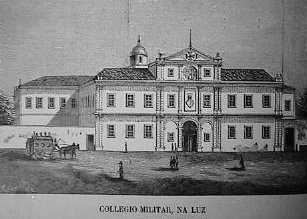
Right: A nineteenth-century engraving of the Colégio Militar, at Luz.
Colégio Militar/Luz: for Benfica's football ground, the 'Estádio da Luz'. Luz is actually the area of Lisbon in which it stands and the word 'luz' happens to mean 'light'. Hence the misnomer 'Stadium of Light' in English usage. Many trains on the Blue Line operate a short-working to Colégio Militar/Luz.
Jardim Zoológico: for the Lisbon Zoo at Sete Rios and the new main coach station.
Marquês de Pombal: for the Parque Eduardo VII and its view over
Lisbon and the Tagus.
Oriente: For Expo 98 and the magnificent Oriente main line railway station by Santiago Calatrava.
Rato: close by is the city end of the eighteenth-century aqueduct. Estrela gardens are a five-minute walk away.
Roma: is a five minute walk from the new Roma/Areeiro CP station for trains to Setúbal and Sintra.
Restauradores: for the Glória funicular
to the Bairro Alto district. The main Tourist Information Office is in the Palácio Foz at
Restauradores, whilst the Rossio railway station, for trains to Sintra, is nearby and linked to the Restauradores Metro station by a subway. A major post office is also sited here.
Santa Apolónia: Opened in late 2007 this station provides a link to the platforms of the railway station of the same name.
São Sebastião: for the Calouste Gulbenkian gardens and museums as well as for the massive Lisbon branch of the Spanish Corte Inglés store chain. The Metro has a dedicated exit into the basement of the store. When the Red line was extended here in 2009 it provided a very useful link across the north of the city but the station itself became more complex to use. If you enter by the station steps on Avenida Duque d'Avila you have to walk down some steps and along the full length of the Red Line platforms before climbing stairs to the Blue Line.
Terreiro do Paço: This waterfront station is convenient both for the new ferry terminal but also for the tram routes that pass through the Praça do Comércio (for which Terreiro do Paço is an alternative name).
Rolling Stock
Original (type ML7) rolling stock was painted red and grey (numbered A1-84). The initial stock of 24 cars was built by Linke-Hoffmann-Busch in Germany and was delivered from 1959. Four of these cars were lost in a fire at Arroios station on 21 May 1976, leaving 20 in service by 1972. The original 24 vehicles had 44 seats and a maximum operational speed of 60km/hr. The others (A25-84) were built in Portugal by Sorefame under licence from the German company.
The original stock was supplemented from 1982 onwards by Sorefame-built units M101 to M156. Until 1999 eighty of the original ML7 cars remained in service in a fleet of 361, but the ML7s were all withdrawn by 28 January, 2000. All stock was then turned out in silver with red ends and light blue doors.
Newer ML90 cars were delivered from March 1993 and reached a total of 57 (19 x 3-car units, distinguished by a door at the front) by 1996. In 1997, 42 ML95 cars were delivered giving a total of 235 cars in service at that time, compared with 142 in 1993. In 1998 new articulated stock was acquired from Siemens-Sorefame. This looks fairly similar to the 1982 stock but has concertina connections between the three cars in each unit and plug doors rather than sliding doors. Cars normally run as two coupled units (i.e. six carriages). These units allow ready access to the full length of the train and also greatly improve security on lightly loaded trains, although these are something of a rarity in Lisbon. In summer 2000, rolling stock carried a red, blue, yellow and green logo to commemorate the Metro's fortieth anniversary of operation but this has since been removed. In 2007, 338 carriages were in service, all of them being in the ML90+ series which was introduced in 1993.
I am grateful to Owen Brison for the following detail: "The 1990s stock, which have plug doors rather than the sliding doors of all the earlier stock, are numbered from 201 upwards but not all consecutively. The motor cars are M201, M203, M204, M206, M207, M209, etc. The trailer cars are R202, R205, R208, where R stands for "reboque", (i.e., towed). Of these, 201 - 206 represent the first two prototype trains while 207 upwards are the production cars with some interior differences. The prototypes (still
in service) have end doors out of the driver's cab; the later cars don't. The two prototype trains are: M201 + R202 + M203 and M204 + R205 + M206. The first production train is: M207 + R208 + M209 and so on. but stopping in the 2xx series. Then the numbering is M301 + R302 + M303 up into the 400s. None of the above cars have concertina walkways. Tha trains without the concertina walkways can be, and indeed are, split into 2-car sets, as trains on the Green line are made up of one or two 2-car sets. The Green line still has two stations, Areeiro and Arroios, which can only take four-car trains.
M501 + R502 + M503,. etc are the first trains with the concertina walkways, folowed by M601 + R602 + M603, etc going up into the 700s. These also have concertina walkways but seats cantilevered from the carriage walls rather than supported by columns at the outer edges. The plug door series all look very similar except for the concertinas... For the exact fleet numbers visit the Metro site's page on Material Circulante.
In 2012 the Metro's rolling stock comprised:
- Type ML90 x 57
- Type ML 95 x 114
- Type ML 97 x 54
- Type ML 99 x 113
- Total 338
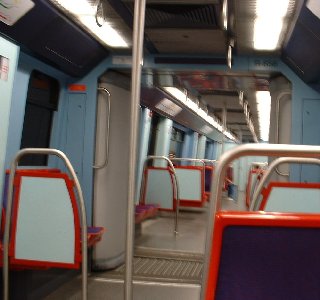
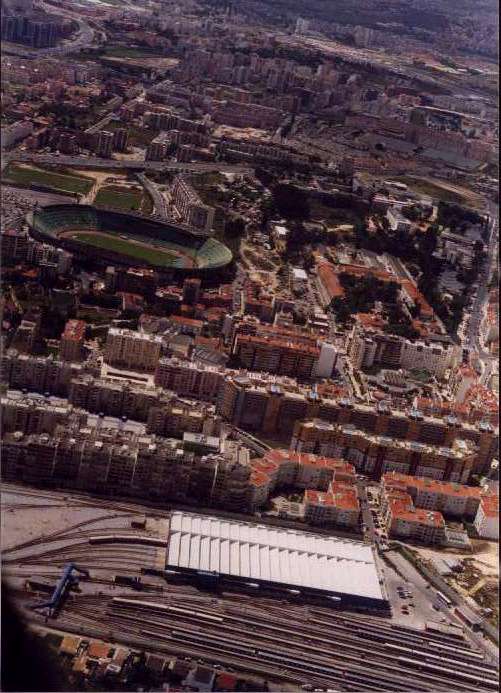
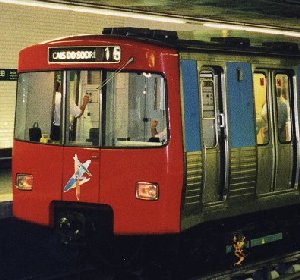
L to R: Inside an articulated Metro unit (2002) ;an aerial view showing the Metro shed and sidings, (at the bottom of the picture), near Campo Grande- nearby can be seen the Estádio José Alvalade, home of Sporting Lisbon football club; new Metro train, bearing 40th anniversary logo on its front, at Baixa-Chiado station in July, 2000.
Tickets
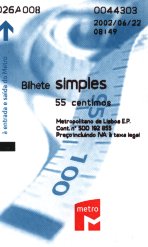
Metro services operate from 0600 to 0100. The easiest way to use the Metro is to purchase a Viva Viagem (or Sete Colinas) electronic ticket (akin to London's Oyster card) costing 0.50 Euros (2012) which can be charged up with monetary value using the machines at every station. Although the Metropolitano de Lisboa is separate from the Lisbon bus and tram operator Carris, the Sete Colinas card is usable on bus and tram services as well as the Metro. A day-ticket covering all Lisbon metro, bus, tram and funicular services costs six Euros in 2016 (it was only 3.70 in 2010) and this can be loaded onto your electronic pass. For more on ticketing see the Carris page.
Left: Metro ticket as used in 2002.
Station Decoration
A major feature of the Metro system is the licence that has been given to major Portuguese artists and ceramicists to decorate the system's stations. The original stations were dimly lit and had green/grey walls of small tiles, with crimson nameboards. Virtually all of these have now been redecorated and many of the newer stations on the Red Line were designed in often striking patterns. However, there was a return to more basic appearance for the latest stations to be completed e.g. Terreiro do Paco and Aeroporto. Sadly, after 2000 the level of graffiti rose astronomically and most stations showed some signs of defacement but this situation has now been rectified and all stations are neat and tidy.
The most memorable central station is, perhaps, Campo Pequeno, with its larger than life human figures, whilst the literary themes of Cidade Universitária, the Lewis Carroll "White Rabbit" tiles at Cais do Sodré the cut-out figures at Marquês de Pombal and the tiled oranges at Laranjeiras are also impressive. A personal favourite is Martim Moniz with its stylised representations of Martim Moniz and of other knights involved in the siege of Lisbon in 1147, as a result of which the city was freed from its Moorish occupiers. The original stations on the Oriente line are much taller and are decorated in striking colours. The newest stations at Terreiro do Paço and Santa Apolónia, and the Red Line extensions at Saldanha and S. Sebastião, are relatively unadorned.
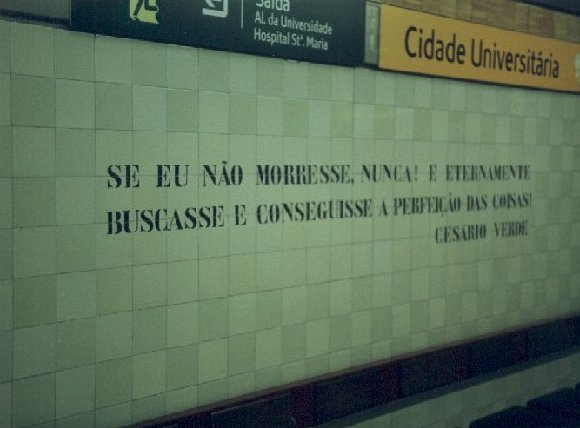

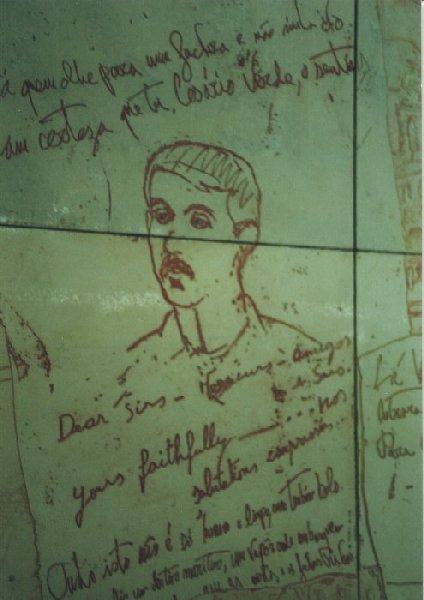
L to R: A quotation from the Lisbon poet Cesário
Verde, (1855-86), on the tile-work walls of Cidade Universitária station; the striking tableau of female figures on the Campo Pequeno platform; another homage to Cesário Verde.
The Metropolitano de Lisboa has its own Web Page, which covers services and also station architecure and design. The northern end of the Blue Line and the Red Line have particularly striking stations, many of which use ceramic tiles, designed by major Portuguese artists, to good effect. A recent book outlines Metro history: Maria Fernanda Rollo, Um Metro e uma cidade; história do Metropolitano de Lisboa, Lisbon, 2000.
Metro do Sul do Tejo (MST): The South of the Tagus Metro
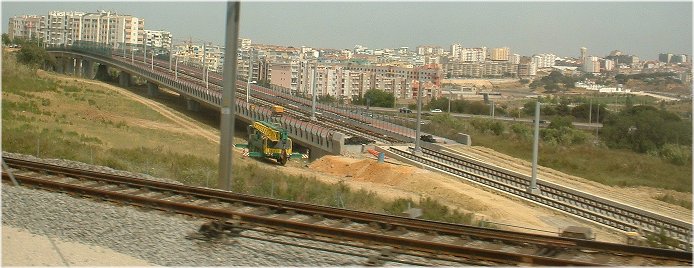
Above: The Metro Sul do Tejo line viaduct near Pragal, where it crosses under the Fertagus cross-Tagus line, in June 2005. The viaduct takes the Metro line over the autoestrada (motorway) which runs south from the Tagus bridge.
A separate webpage has now been established for this new (2007) metro system on the south bank of the Tagus, click here.
Metro Ligeiro de Superfície (Surface-Running Light Metro)
A new Metro Ligeiro de Superfície (Surface-Running Light Metro) has been planned to run around Lisbon at a cost of €949.7 million, of which 227.2 were for associated works. There will be an outer ring route of 24.7km (if it is ever built). This will comprise an Algés to Falagueira section (12.6km), costing 232 million euros and a Falagueira to Loures link of 12.1km, costing 222.7 million euros. Loures is near Lisbon airport.
The inner ring will link Metro and railway routes by connecting Falagueira, shortly to be added to the Metro network, to the Lisbon railway terminal of Santa Apolónia, a distance of 11.5km, costing 211.6 million euros. There will also be a connection between Alcântara, to the west of Lisbon, with Gare do Oriente, the station opened for the Expo 98 event, to the north east of the city. This comprises 15.4km which will cost 283.4 million euros.
No firm timescales have been announced for the above projects by the Ministry of Public Works, which is hoping for a public-private partnership to achieve these goals. The Metropolitano de Lisboa and Carris companies will be involved as will be the respective local councils in the areas concerned.
Copyright: ©
Contact: the following is not a link; please transcribe the address into your email 

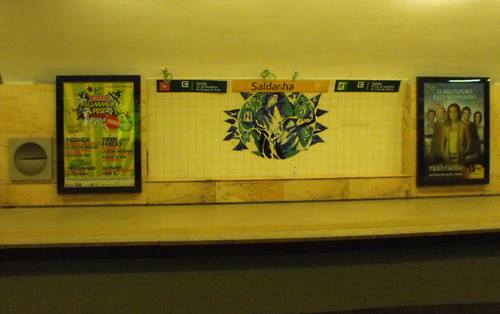
 4 August 2017
4 August 2017













